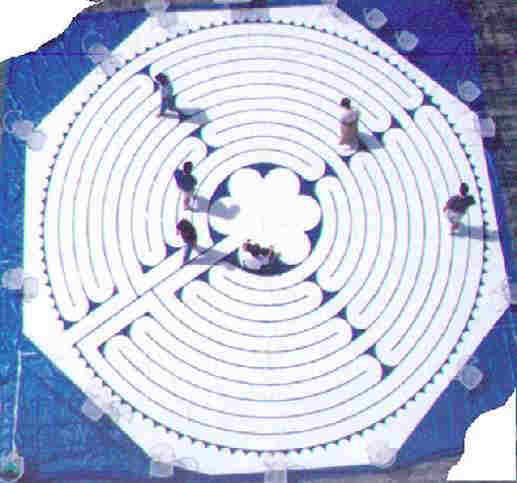 CHARTRES STYLE 11 CIRCUIT LABYRINTHS
CHARTRES STYLE 11 CIRCUIT LABYRINTHS CHARTRES STYLE 11 CIRCUIT LABYRINTHS
CHARTRES STYLE 11 CIRCUIT LABYRINTHS
The PAXWORKS 11-circuit Labyrinths are scale replicas of an ancient labyrinth constructed around 1200 AD in the stone floor of Chartres Cathedral, France. Medieval Christians visited Chartres (and other cathedrals) and walked the labyrinth as an alternative to taking a hazardous pilgrimage to Jerusalem to walk in the "foot steps of Christ." Modern "pilgrims" walk the labyrinthine path as one of many tools to enhance prayer, contemplation, meditation, and/or personal growth.
Many churches and community organizations are making labyrinths available for public use. (to find one in your area, see our labyrinth listings pages.
WALKING A LABYRINTH in 5 steps
1) Environment:
Begin by setting the environment for the experience. At organized walks, your host or facilitator has already prepared an environment by adjusting lighting, selecting music, controlling air conditioners, and saying opening prayers.Set your personal environment by dropping your 'physical baggage' i.e. set aside bulky or noisy items like key-chains, pocket change, pagers, cell-phones and dangling jewelry. We especially encourage walkers to take off watches to remove the temptation to measure the walk's progress chronologically. Many indoor labyrinths ask you to remove you shoes and walk in socks. A barefoot walk on an outdoor grass labyrinth is awesome!
The Walk:
There is no required way to walk a labyrinth. The beauty of the labyrinth is that people can approach the experience on their own terms. However, as a guideline, traditional scholars have broken the ‘walk’ down into three stages.2) Entering:
(also referred to as shedding or purgation.) During this stage you walk the path toward the center, and should try to eliminate worldly concerns and quiet the mind.3) Illumination:
The time spent in the center. This is a time of openness and peacefulness; you experience, learn or receive what this unique moment offers. Take your time.4) Union:
The journey outward. You choose when to leave the center, following the same path. This is a time to consider what occurred in the center and how it may be applied in your life.5) Implementation:
This stage represents your life outside the labyrinth; the world where your experience or illumination is carried into and affects your everyday life.FINGER-WALKING A PERSONAL LABYRINTH
A personal labyrinth can be made on paper, wood, clay, pewter, plastic, canvas or other material. Typically, they are 5 to 18 inches diameter.
Begin by setting the environment to your liking. Find a comfortable chair, location, or position. Remove jewelry, watches, bracelets, etc. Set music or background sounds. Adjust the lighting.
Acquaint yourself with the labyrinth, pass your hands over the edges, across the center and around the outer edge; examine the detailed carvings, identify the variances in the wood grains or material that make this labyrinth unique.
Adapt your breathing, try closing your eyes and begin tracing the path from the outside with one or more fingers, following the groove toward the center. When you arrive at the center, stay a while.
Complete your experience by retracing the path from the center outward.
THE PAXWORKS PERSONAL LABYRINTH:
 The PAXWORKS Personal Labyrinth is
constructed of fully cured quality hardwoods with a durable satin finish. The natural
materials make this labyrinth unique in all creation. Maintain it with any high quality
furniture cleaner or polish. We have added a ‘keyhole slot’ in the back for
convenient hanging as a fine piece of artwork.
The PAXWORKS Personal Labyrinth is
constructed of fully cured quality hardwoods with a durable satin finish. The natural
materials make this labyrinth unique in all creation. Maintain it with any high quality
furniture cleaner or polish. We have added a ‘keyhole slot’ in the back for
convenient hanging as a fine piece of artwork.
PAXWORKS - -
WWW.PAXWORKS.COMP.O. Box 502244 – Indianapolis, IN 46250-2244